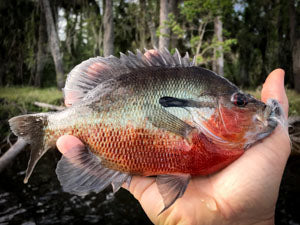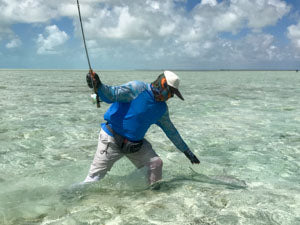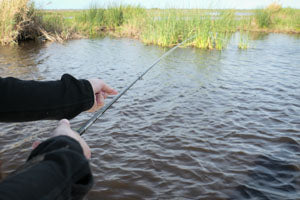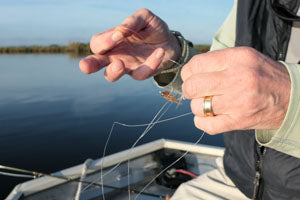First Cast to First Fish: Part 5 - Go Fishing
Part 5: Go fishing
What to Bring
By now you should have a rod and reel, between 5wt and 8wt, at your disposal and be able to make a basic short cast. There are a few things you need to get together, then it’s time to hit the water. If you are in an area with a healthy population of panfish, we recommend you start by targeting them.
You will need the following:
- 2 or 3 10 lb bass or saltwater leaders
- A small fly box
- 5 or 6 small panfish poppers (# 6 through #10)
- 3 or 4 small streamers or nymphs (#4 through #8). These could be baitfish patterns, damselfly or dragonfly imitations, or Wooly Buggers.
- A pair of hemocuts (hemostats with built in cutters) or hemostats and nippers.
- Glasses (preferably polarized sunglasses)
Find Some Water
 Panfish, including bluegill redbreasted sunfish, redear sunfish, pumpkinseed and others, as well as largemouth bass, aren’t terribly picky and inhabit a wide range of freshwater habitats in most US states. If you live near us, in Central Florida, you won’t have to drive further than a few minutes to find a lake or pond with good fishing. Our "Fly Fishing Central Florida" page will help you get started. If you need help finding a place to fish, ask friends and family if they have access to any streams or ponds you can fish or get in touch with your local fly shop or bait shop.
Panfish, including bluegill redbreasted sunfish, redear sunfish, pumpkinseed and others, as well as largemouth bass, aren’t terribly picky and inhabit a wide range of freshwater habitats in most US states. If you live near us, in Central Florida, you won’t have to drive further than a few minutes to find a lake or pond with good fishing. Our "Fly Fishing Central Florida" page will help you get started. If you need help finding a place to fish, ask friends and family if they have access to any streams or ponds you can fish or get in touch with your local fly shop or bait shop.
Once you locate some fishable water, stop by for a visit – hopefully with your rod, reel and other equipment. The first thing to check for is shoreline access with room for a back cast. Ideally you’ll be able to walk right down to a section of the shoreline without much vegetation. Fishing from a dock works fine as long as it’s not too high off the water, is relatively open and doesn’t have railings.
If the area looks fishable, get your rod and reel out of your car and put them together. If this is your first time out, tie on a small popper or other floating fly, using either a nonslip mono loop or a clinch knot. Put on your glasses, preferably polarized sunglasses which will not only protect your eyes from bad casts but also help you to see into the water.
Use your hemostats to pinch down, or flatten, the barb on your hook. The barb is the small point of metal that protrudes from the inside of the hook just below the hook point. Its purpose is to keep the hook from easily slipping out of the fish’s jaw. The barb also makes the hook difficult to remove from your arm if you should make a particularly bad cast. To pinch the barb, grab the end of the hook, with one side of the hemostat jaws against the barb and the other against the opposite side of the hook. Squeeze the barb into the hook to flatten it down. A fish is unlikely to escape from a de-barbed hook as long as you maintain tension while you are fighting it.
Basic Fly Fishing Strategy
Before making a cast, take a few minutes to look around. Is there any nearby structure? This could be a dock or other structure, lily pads, a ledge or a fallen tree. Panfish and bass orient to structure so these would be the first places to try.
For your first cast, strip out some slack, drop your fly on the water, and shake your rod tip to get the extra line out of the rod tip. Do a quick roll cast to straighten out your line. If there is some good structure nearby or if the edge is deep enough to hold fish, a short roll cast may be all you need to catch your first fish on a fly rod. If not, raise your rod up until the slack is gone and your rod starts to bend, make a back cast, and drop the fly in an area where you think there may be a fish.
Keep your rod tip near the water's surface and pointed at your fly. This will keep the slack out. Use your line hand to strip the fly gently so it moves across the water, making ripples the fish will see and key in on. Strip by holding the fly line in your line hand and sliding it back away from the reel. Using the pointer and middle finger of your rod hand, trap the fly line against the rod grip. Then reach forward with your line hand and grab the fly line behind your rod hand for another strip.
If nothing eats, give the fly a couple more strips. Wait a few more seconds then strip several more times. At this point it’s time to pick the fly up and drop it in a new spot.
When a fish eats, use your line hand to tighten up the line and raise your rod tip. If the fish is there, this should be enough pressure to set the hook. If the fish misses, just make a back cast and drop the fly in the same place.
If the popper isn’t working and you think there are fish in the area, try one of your subsurface flies. If you see little baitfish around the edges, especially if they are being chased by bass or panfish, tie on a small baitfish pattern. If not, then a wooly bugger or dragonfly or damselfly nymph may be a better choice. If you choose a baitfish pattern, start with short, erratic strips followed by a pause, letting the fly sink for a second or two. Eats often come during the pause. If that’s not working, try longer, steadier strips. Once you find a motion that works, stick with it. If you chose something other than a baitfish pattern, cast near structure and try a short, steady strip.
The hookset will be a little different with a subsurface fly. If your rod tip is where it should be when the fish eats (pointed at the fish and near the water’s surface), you will be in a good position for a strip strike. Strip until the line comes tight then slide your line hand back while moving the rod to the side to apply more pressure to the fish. Don’t bring the tip of the rod too far back or you will lose pressure and the fish may escape.
Playing, Landing and Releasing Fish
Once you hook the fish, the first thing to remember is to keep the line tight. If the fish is given slack, it will likely escape. The best way to keep slack out of the system is to keep the rod tip from getting too high. Try to keep it at a 60 degree angle (relative to the water) or less. If your rod tip gets too high tighten up by stripping line in quickly, backing away from the fish, or both. We wrote a blog post on "Leverage" that provide some additional information on how to fight fish effectively.
Fight the fish by moving the rod tip in the direction opposite where the fish wants to go and to the side. This puts the fish off balance and will tire it quickly. Unless the fish is large enough to pull the slack out of your hands and get on the reel, just use your line hand to pull in and give up line when necessary. When the fish seems tired enough to land, slide it into the shallows.
 Landing a fish on a fly rod is a little tricky. You have a 9’ rod and a 9’ leader you need to deal with. Stop stripping when you still have 3 or 4 feet of fly line extending from the tip of the rod. Trap the loose fly line between one or two of the fingers of your rod hand and the rod grip and move the rod tip away from you so that the leader crosses within reach. Be careful not to put excessive force on the rod tip and not to pull straight down. Once you have the leader in your line hand, release pressure on the rod and guide the fish to where you can pick it up.
Landing a fish on a fly rod is a little tricky. You have a 9’ rod and a 9’ leader you need to deal with. Stop stripping when you still have 3 or 4 feet of fly line extending from the tip of the rod. Trap the loose fly line between one or two of the fingers of your rod hand and the rod grip and move the rod tip away from you so that the leader crosses within reach. Be careful not to put excessive force on the rod tip and not to pull straight down. Once you have the leader in your line hand, release pressure on the rod and guide the fish to where you can pick it up.
An appropriately sized net makes the landing process much easier, especially if you are fishing with someone else who is able to help. A landing net, used well, will shorten the fight, help you land more fish, and because you will be able to land fish more quickly, the fish will have more energy when released. When using a net to land a fish, don’t make swipes at the fish. Instead wait until the fish is sufficiently tired that you can control its direction and angle. Place the net in the water, below where the fish will be, and guide the fish into it.
Congratulations! You have your first fish. Take a couple pictures and let it go. If the hook is in the fish’s lip, the fly will likely be easy to grab and pop out. You removed the barb, right? If the fly is deeper, you may need to use your hemostats to gently grab the fly and back it out. If you have trouble removing the hook, put the fish back in the water for a short break before trying again. Keep fish in the water as much as possible, and avoid dragging them onto dry ground, grabbing them with a cloth, or doing anything else that may remove their slime coat.
Pay attention to what you were doing when you caught your fish and where it came from. As you spend time on the water, you will discover patterns and learn more about when and where you are likely to catch fish.
After letting your fish go, slide your line back out of the tip of the rod, by laying the fly on the water and shaking the rod tip back and forth or just quickly moving the rod tip parallel to the surface and away from the fly. If you strip your line too far in, the weight of the line inside the guides may pull the leader through until the fly is right at the rod tip. If this happens, put the rod butt and reel down on the grass or other soft surface, and carefully pull the leader and a couple feet of line through the rod tip.
Dealing with Problems
 At some point you will snag something either in the water or in the air while you are casting. When that happens, do NOT use the rod to try to pull the fly free. There are some advanced tricks that often work to free flies from snags but, for now, we’ll keep it simple. Start by pointing the rod directly at the fly, stripping until the line is tight, and either holding onto the line with your line hand or trapping the fly line between your fingers and the rod grip. The fly line should extend from your fingers straight through the line guides to the snag. There should be no force at all on the rod. Keeping the angle consistent, move the rod away from the snag, increasing line tension until the fly either comes free or the thin portion of your leader, the tippet, breaks. It’s a good idea to look away and warn others to do so as well since the fly, or broken leader, often comes at you quickly.
At some point you will snag something either in the water or in the air while you are casting. When that happens, do NOT use the rod to try to pull the fly free. There are some advanced tricks that often work to free flies from snags but, for now, we’ll keep it simple. Start by pointing the rod directly at the fly, stripping until the line is tight, and either holding onto the line with your line hand or trapping the fly line between your fingers and the rod grip. The fly line should extend from your fingers straight through the line guides to the snag. There should be no force at all on the rod. Keeping the angle consistent, move the rod away from the snag, increasing line tension until the fly either comes free or the thin portion of your leader, the tippet, breaks. It’s a good idea to look away and warn others to do so as well since the fly, or broken leader, often comes at you quickly.
If the fly comes off, check to make sure the hook isn’t bent. It’s also a good idea to check for wind knots (actually “casting knots”) which are knots accidentally tied in your leader while you are casting. These will weaken the leader and, especially if they are simple overhand knots, should be untied or cut out.
Another problem we all face is tangled fly line and leaders. Fly line has a propensity to wrap around everything, including you, your fly rod, coolers and vegetation. Line management is an important part of fly fishing. Where your fly line is on the ground is nearly as important as where it is in the air. Only strip as much line out as you need, try to place it into a relatively clean area without snags, and make sure it is stacked in loose coils so that the coils on top are the ones that will be heading through the guides and out the tip of the rod first with your next cast. If you simply strip line off the reel and drop it at your feet it will be “reverse stacked,” with the front of the line underneath the back of the line and will likely tangle if you try to cast without rearranging it first.
 We all occasionally tangle our leaders while casting, either because of a poor cast, a tree in our back cast we did not see in time, excessive wind or some other reason. When your leader is tangled it will often make a different noise as it travels through the air. If something seems different, stop right away and check. If you keep casting it will only get worse. With a little patience, knots that haven’t been tightened down can usually be removed. It’s a good idea to have a spare leader ready if the tangle is too bad to realistically untangle on the water.
We all occasionally tangle our leaders while casting, either because of a poor cast, a tree in our back cast we did not see in time, excessive wind or some other reason. When your leader is tangled it will often make a different noise as it travels through the air. If something seems different, stop right away and check. If you keep casting it will only get worse. With a little patience, knots that haven’t been tightened down can usually be removed. It’s a good idea to have a spare leader ready if the tangle is too bad to realistically untangle on the water.
Check your rod from time to time to make sure the sections are fully seated (pushed together securely). Loose sections can fly off while you are casting, and ferrules can split. Get into the habit of checking after fighting a fish, removing a tangle, freeing a snag or tying on a new fly.
Moving Forward
As you spend time on the water, your skills and confidence will increase. Casting will become second nature and you will catch more and larger fish. Pretty soon you’ll be looking for new challenges. Fortunately, there are plenty. There will always be a new species to catch, new places to fish, and new flies to try. We hope you enjoy fly fishing as much as we do and we look forward to helping you in any way we can.














